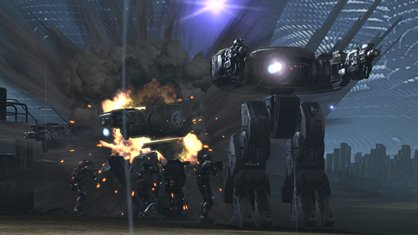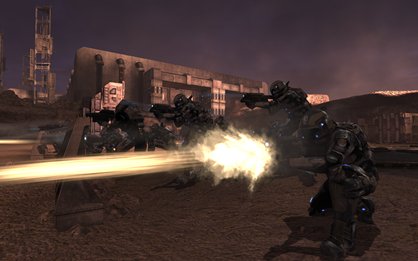Tiberium
We're ordered into a field of suspiciously glowing rocks by an unseen godlike commander...
Forget global warming - the greatest threat to planet Earth and the survival of mankind is a green radioactive extraterrestrial crystal that is spreading like a cancer across the entire surface of the globe. Or maybe Deal or No Deal.

“Tiberium is the catalyst for everything, it’s our One Ring, our Matrix, our Force, and that’s why it’s the name,” says executive producer Christopher Plummer. “We really want to take people deep into this universe - unravel these great mysteries and mythologies. We hired in scientists to work on the science of tiberium, such as how it works at a molecular level, for example. These elements allow the universe to really hang together and allow us to present our ideas with conviction. I think if we do our job right, Tiberium will be for both C&C fans and gamers who’ve never played it. This isn’t a strategy game, it’s a shooter with tactical elements. You’ll recognize certain bits from C&C, but this is a story-driven FPS concentrating on action rather than building bases.”
What makes Tiberium truly unique is the ability to reinforce and command up to four squads during missions, with a choice of infantry, armored units, and air units. Infantry are great against other ground troops and for capturing areas including valuable drop zones (for calling in squads), and tiberium fissures (indicated by green gas) where you can summon a large tiberium spike from above to grant you reinforcements. Armored units, meanwhile, including the impressive Titan mech, are slower but pack a larger punch against installations, and allow you to take cover behind their bulky, metal legs. Finally, air units are fast, good for accessing areas unreachable by foot and great at targeting a wide area, but vulnerable to attack from ground units.

All these types of units give you choice during battles and, most importantly, the mission isn’t over if a squad is killed - all you do is call in another bunch of cannon fodder, or maybe a different unit to try a new tactic on-the-fly. Also, they’re controlled simply by pressing one button for each squad, with the AI reacting to whatever situation they’re in automatically. “If you put them close to a wall, they’ll take cover - you don’t have to tell them,” adds Plummer. “We’ve just made the decision-making more about the movement and the action - which thing do you want to attack next?”
Sign up to the GamesRadar+ Newsletter
Weekly digests, tales from the communities you love, and more


